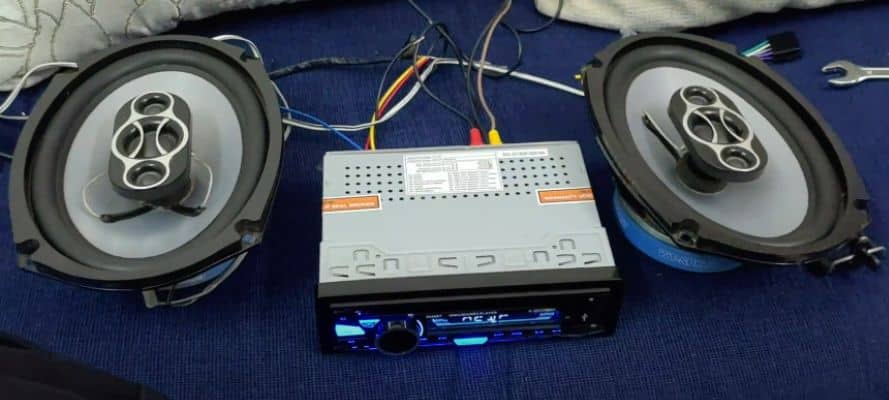Many car owners often ask, “Does a Single DIN head unit improve sound Quality?” the answer is absolutely 'yes' and here's why it matters. Breaking away from a basic factory stereo and installing a well-built Single DIN head unit can noticeably improve your car’s sound quality. After working firsthand with a wide range of car audio systems, I’ve seen how often the head unit gets overlooked even though it plays a central role in sound processing.
The difference usually comes down to a cleaner signal path, better digital-to-analog conversion (DAC), and advanced tuning options like time alignment and parametric EQ. Some models even support FLAC playback or high-voltage pre-outs, giving your amps and speakers a much cleaner feed.
Let’s now examine how these features translate into measurable improvements in audio output.
In This Article
- How Does a Head Unit Impacts Sound Quality?
- Single DIN vs Factory Stereo – Technical Comparison
- Top Reasons to Upgrade to a Single DIN Head Unit
- When a Single DIN Head Unit Might Not Improve Sound Quality
- Real-Life Results: What You Can Expect from the Upgrade
- Common Myths About Single DIN Sound Quality
- Should You Upgrade? My Expert Recommendation
How Does a Head Unit Impacts Sound Quality?
Your car stereo is more than just a music player. It serves as the control center for your entire audio system. When evaluating poor sound quality, I always recommend checking the head unit first. A high-quality Single DIN head unit can significantly improve your listening experience by processing signals more accurately and efficiently than most factory stereos. Here are the duties of a head unit in audio processing:
The Head Unit’s Role in Audio Processing
1. Digital-to-Analog Converter (DAC): Converts digital audio signals into analog so your speakers can reproduce them. A quality DAC often results in fuller tones, tighter bass, and a more realistic soundstage. I’ve noticed the difference across multiple setups.
2. Internal Equalizer (EQ): Allows you to adjust frequency levels to suit your preference and your vehicle’s acoustics. I often rely on the EQ to smooth out harsh mids or control excessive bass.
3. Preamp Outputs: Provide a clean signal to external amplifiers. This helps reduce distortion and improves overall sound clarity when running aftermarket amps or speakers.
4. Power Output: Delivers higher RMS wattage per channel than typical factory units. This extra power gives you better volume control, more dynamic range, and cleaner sound reproduction at higher levels.
Single DIN vs Factory Stereo – Technical Comparison
Factory stereos often lack the performance features found in aftermarket Single DIN units. I’ve tested these systems side-by-side, and the difference is immediately noticeable. Here’s a quick technical breakdown:
Feature | Factory Stereo | Aftermarket Single DIN |
|---|---|---|
DAC Quality | Basic | High-end |
EQ Options | Limited or None | Multi-band |
Preamp Outputs | Often None | Multiple |
Power Output (RMS) | ~10–15W per channel | ~20–25W per channel |
Audio Format Support | MP3, WMA | MP3, WMA, FLAC, WAV, AAC |
If you're torn between factory and aftermarket, check my detailed guide on Factory Head Unit vs Aftermarket – What’s Better?.
Top Reasons to Upgrade to a Single DIN Head Unit
When I upgraded my own system, I noticed a distinct improvement in detail, clarity, and control. A better head unit unlocked richer audio and modern format support, even without upgrading other components. Here are the benefits:
1. Cleaner Sound and Better Volume Control
With higher RMS output and better signal processing, your music will sound more dynamic with less distortion, especially at higher volumes.
2. Advanced Audio Customization
Expect more control with features like time alignment, crossover management, and multi-band EQ.
3. Support for High-Resolution Audio Formats
These units often support lossless formats like FLAC or modern Bluetooth codecs such as aptX, ensuring better fidelity even over wireless connections.
When a Single DIN Head Unit Might Not Improve Sound Quality
It’s important to set realistic expectations. Some users feel underwhelmed because they don’t address other weak links in the system. Here are situations where the upgrade might not deliver expected results.
1. Weak Speakers or Wiring
If the rest of your system is subpar, the improvements from a new head unit might be limited.
2. Incompatible or Low-End Units
Cheaper aftermarket units without proper preamp outputs or tuning flexibility may not deliver a noticeable upgrade.
3. Unrealistic Expectations
A head unit alone won’t create booming bass or theater-level audio. It works best when paired with quality speakers, amps, and power infrastructure.
Real-Life Results: What You Can Expect from the Upgrade
I’ve installed Single DIN units in everything from daily drivers to show cars. Even budget models like the Pioneer MVH-S322BT outperform factory systems in clarity and responsiveness. Premium units from Alpine or Kenwood’s eXcelon series deliver top-tier performance when integrated into a well-matched system.
Whether you’re just looking for cleaner daily audio or laying the groundwork for a full build, a Single DIN head unit is a smart starting point. For those still debating the upgrade, don’t miss our full guide comparing Factory vs Aftermarket Head Units.
Common Myths About Single DIN Sound Quality
Many users approach upgrades with common misconceptions that lead to unrealistic expectations. Let’s clear up a few things I hear regularly:
- "A new head unit always makes bass better." Not unless it’s paired with quality speakers or a sub.
- "All aftermarket units are better than factory ones." Some cheap units actually perform worse. Always check specs, brand reputation, and user reviews.
If you’ve already upgraded and still face problems like distortion or no sound, check out These troubleshooting guides.
Should You Upgrade? My Expert Recommendation
If your factory stereo sounds flat or lacks essential features, a Single DIN upgrade is one of the most impactful and cost-effective moves you can make. I always recommend starting with the head unit before moving on to amps, speakers, or power upgrades.
For best results, match it with upgraded wiring, efficient speakers, and a clean power supply. It’s the foundation of any great car audio system.
Explore More Car Audio Guides:

